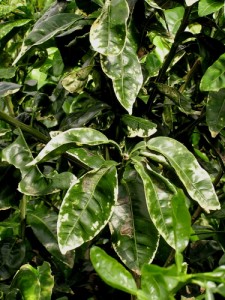Citrus Leafminers
 Question from Sandy:
Question from Sandy:
A HUGE favor! It pains me to see the very newest leaves of our booming citrus trees, still curling w those leaf-miners, even after spraying. ANY suggestions you might send (or re-send!) would be so appreciated!
Answer from Pat:
It seems as if all the citrus trees I see these days have curled leaves. I even noticed that all the citrus trees in Italy were suffering from the same affliction. Amalfi is a big lemon-growing area and all the lemon trees that cover the hillsides looked slightly yellowish and had curled leaves. I could tell you how to spray with a systemic pesticide or how to use one to drench the roots. This would get rid of curled leaves and the leaf miners and any other pest quickly, but then you would get cancer—if you ate the fruit. Aren’t curled leaves better than that? All systemic pesticides are carcinogens. So really it’s best not to worry too much and let nature take its course. Our Dept. of Agriculture is continually trying to find predatory wasps and other insects or arachnids to prey on the bad guys who lay their eggs on citrus trees thus giving their larvae carte blanche to bore their little tunnels into the leaves. The more beneficial creatures one can encourage to set up housekeeping in one’s garden, the more likely it is that pests will be controlled—sometimes even eliminated.
Nonetheless, there one possible organic cure but please note the word “possible”. Some people swear by this cure and other people say it did not work for them. Personally, I think the answer is persistence. If curled leaves on citrus bother you that much, I would try it. Here is the system: Cover the top of the soil over the roots with a layer 1 to 2 inches thick of dry, bagged “Wormgold” worm castings. When watering, the irrigation water will penetrate the worm castings and adequately water the plant. However, it may take a little more water to properly irrigate your plants. Keep a layer of worm castings over the roots this way. It will take some months for the situation to clear up and meanwhile you should continue to replace the worm castings once a year. This method completely cleans up the leaves of begonias that have been attacked by giant white flies. They disappear 2 weeks after you apply the worm castings. When the pests are already inside the plant the cure will take longer. The exoskeletons of insects are made of chitin. Chitinase is an enzyme that destroys chitin. All plants contain chitinase. Worm castings contain a lot of it. The plant has to absorb more than the normal amount of chitinase from the wormcastings and then that chitinase will attack the chitin in the leaf miners. That is the theory. It takes time to work.

